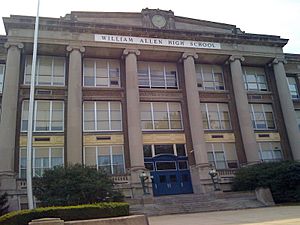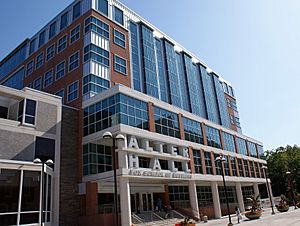Education in Pennsylvania facts for kids
Pennsylvania has many schools and colleges. These include public schools, private schools, and many universities. In Pennsylvania, kids must go to school from age 8 until age 17. They can also leave school earlier if they graduate from high school.
In 2018, about 90% of students in Pennsylvania graduated from high school. Also, about 27.5% of people went on to get a bachelor's degree or higher. This shows that many Pennsylvanians value education.
Contents
Learning in Elementary and High Schools
Pennsylvania's public schools are run by local school boards. These board members are chosen by people in the community. Public schools get money from the state government and local taxes.
There are many kinds of public schools. These include elementary schools, middle schools, and high schools. There are also special schools like vocational-technical schools and charter schools. Each school has a principal. The principal works with a superintendent, who leads the whole school district.
Pennsylvania has 500 public school districts. These districts have 3,287 schools and 120 charter schools. Some districts do not have high schools because they have fewer students. In the 2005-2006 school year, about 1.87 million students were in public schools. The average cost per student was about $10,738. There were about 15 students for every teacher.
In the 2007-2008 school year, about 265,545 students attended private schools. Students in Pennsylvania often do well on state tests. For example, in 2007, 8th graders ranked high in math, reading, and writing. Pennsylvania spends a lot of money on public education. In 2009, it spent about $25 billion.
How Education is Managed
The Pennsylvania Department of Education helps manage schools and colleges. The secretary of education leads this department. The governor chooses this person, and the state senate must agree.
The State Board of Education makes many rules for schools. This board decides if new school districts can be created. It also helps manage money from the government for education. The board creates plans for both basic and higher education. It also sets rules for the secretary of education to follow.
The State Board of Education has 22 members. Most members are chosen by the governor. They serve for six years. Some members are also from the state government. The secretary of education is also part of the board but does not vote.
Pennsylvania is divided into 29 intermediate units. These units help public schools and private schools. They provide services and support to many different schools.
Going to College and University
Pennsylvania has many private colleges and universities. It also has many public community colleges and universities. The state helps fund several groups of universities. These include the Commonwealth System of Higher Education and the Pennsylvania State System of Higher Education. There are also 14 community colleges.
Commonwealth System of Higher Education
This system has four major universities. They get public money but run themselves.
- Lincoln University (Pennsylvania): About 2,000 students attend this university.
- Pennsylvania State University: This is one of the largest public universities in the U.S. It has over 84,000 students at 24 campuses. The main campus is in State College.
- Temple University: Over 34,000 students attend Temple University. It has campuses in the Philadelphia area.
- University of Pittsburgh: About 34,000 students go to the University of Pittsburgh. It is located in western Pennsylvania.
Pennsylvania State System of Higher Education
This system includes 14 universities. More than 112,500 students are enrolled here. A board of governors leads this system. The governor of Pennsylvania chooses some members. Others are chosen by state lawmakers. Students from the universities also serve on the board.
Community Colleges
Community colleges offer programs that can lead to jobs or transfer to four-year colleges. In the 2005-2006 school year, about 189,000 students were in credit programs. Many more were in non-credit programs. The average cost for tuition and fees was about $2,327 per year. Many students from community colleges move on to four-year universities.
Getting Help with College Costs
The Pennsylvania Higher Education Assistance Agency helps students pay for college. It offers grants, loans, and other services. This agency helps students afford higher education.
History of Education in Pennsylvania
In the past, most children in Pennsylvania learned at home or in private schools. This was true until the Civil War. Public schools started to become common in the late 1800s.
Records from 1771-1817 show that more children were getting an education. Also, more students were going to schools instead of learning at home. This helped many people learn to read and write by 1840.
The Pennsylvania Department of Education started in 1834. The State Board of Education, which makes rules for schools, was created in 1963.
German Culture and Schools
Many German immigrants came to Pennsylvania. Schools were important for keeping their culture alive. Some German language schools did well, especially in cities. Benjamin Franklin even helped create free schools for German students. These schools aimed to help students learn English too.
In 1787, the first German college in the United States was founded. It was called Franklin College in Lancaster. Later, it became Franklin and Marshall College.
Early Colleges and Universities
The University of Pennsylvania is one of the oldest colleges in America. Benjamin Franklin founded it in 1740.
Lincoln University was founded in 1854. It was the first historically black university in the nation. It offered arts and sciences education to African-American students.




